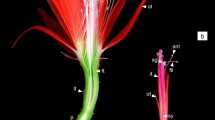Abstract
We investigated the degree of organogenesis completed at the end of the growing season in pistillate flowers of heterodichogamous Juglans regia, English or Persian walnut. Terminal buds from paired cultivars, one each protandrous and protogynous, chosen to represent early, midseason and late leafing walnuts, were examined by scanning electron microscopy. Results indicate that pistillate floral primordia in protandrous individuals had not progressed beyond involucre initiation during the season prior to bloom. In protogynous individuals, floral differentiation had progressed to the initiation of perianth primordia. These observations are compared with an earlier report on staminate flower differentiation in the same cultivars where a comparable, but opposite, relationship exists. We conclude that the degree of differentiation in both staminate and pistillate flowers that must be completed between the time growth resumes in the spring and anthesis is a developmental determinant of the mode of heterodichogamy in walnut.
Similar content being viewed by others
Author information
Authors and Affiliations
Additional information
Received: 15 June 1996 / Revision accepted: 25 October 1996
Rights and permissions
About this article
Cite this article
Polito, V., Pinney, K. The relationship between phenology of pistillate flower organogenesis and mode of heterodichogamy in Juglans regia L. (Juglandaceae). Sex Plant Reprod 10, 36–39 (1997). https://doi.org/10.1007/s004970050065
Issue Date:
DOI: https://doi.org/10.1007/s004970050065




